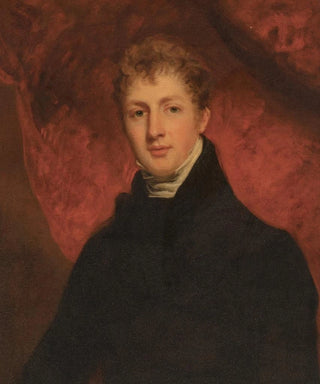Art print | Honorable James William Dillon 1792-1812 Son of Charles Dillon 12th Viscount - John Hoppner


View from behind

Frame (optional)
In the fascinating world of early 19th-century British painting, the art print "Honorable James William Dillon 1792-1812 Son of Charles Dillon, 12th Viscount" by John Hoppner stands out for its ability to capture not only the physical appearance of its subject but also his very essence. This portrait goes beyond simply depicting an aristocrat of the time; it evokes a bygone world where values of honor and nobility were at the heart of social interactions. Through this art print, viewers are invited to delve into the history of the Dillon family, as well as to explore the subtleties of an art form that transcends mere visual representation to touch on human psychology.
Style and uniqueness of the work
John Hoppner's style, characterized by a realistic portrait technique and delicate colors, is fully expressed in this piece. Known for his mastery of light and shadow, Hoppner manages to bring the face of James William Dillon to life, while incorporating decorative elements that enrich the portrait's context. The sumptuous drapery and refined details of the aristocratic attire demonstrate a meticulous attention to detail and an aesthetic pursuit that have made the artist renowned. The composition, both classic and dynamic, creates a visual interaction between the subject and the viewer, making the experience of contemplation deeply immersive. This work is thus a perfect illustration of portrait art that, while rooted in tradition, stands out for its ability to evoke emotions and reflections.
The artist and his influence
John Hoppner, born in 1758, is one of the most prominent portraitists of his era, rivaling artists such as Sir Joshua Reynolds. His training and experience led him to develop a unique style, combining realism and expressiveness. As a member of the Royal Academy, Hoppner played a key role in the evolution of British portraiture, influencing many artists who followed in his footsteps. His innovative approach, which blends meticulous attention to detail with psychological sensitivity, helped redefine aristocratic portraiture.

Matte finish

View from behind

Frame (optional)
In the fascinating world of early 19th-century British painting, the art print "Honorable James William Dillon 1792-1812 Son of Charles Dillon, 12th Viscount" by John Hoppner stands out for its ability to capture not only the physical appearance of its subject but also his very essence. This portrait goes beyond simply depicting an aristocrat of the time; it evokes a bygone world where values of honor and nobility were at the heart of social interactions. Through this art print, viewers are invited to delve into the history of the Dillon family, as well as to explore the subtleties of an art form that transcends mere visual representation to touch on human psychology.
Style and uniqueness of the work
John Hoppner's style, characterized by a realistic portrait technique and delicate colors, is fully expressed in this piece. Known for his mastery of light and shadow, Hoppner manages to bring the face of James William Dillon to life, while incorporating decorative elements that enrich the portrait's context. The sumptuous drapery and refined details of the aristocratic attire demonstrate a meticulous attention to detail and an aesthetic pursuit that have made the artist renowned. The composition, both classic and dynamic, creates a visual interaction between the subject and the viewer, making the experience of contemplation deeply immersive. This work is thus a perfect illustration of portrait art that, while rooted in tradition, stands out for its ability to evoke emotions and reflections.
The artist and his influence
John Hoppner, born in 1758, is one of the most prominent portraitists of his era, rivaling artists such as Sir Joshua Reynolds. His training and experience led him to develop a unique style, combining realism and expressiveness. As a member of the Royal Academy, Hoppner played a key role in the evolution of British portraiture, influencing many artists who followed in his footsteps. His innovative approach, which blends meticulous attention to detail with psychological sensitivity, helped redefine aristocratic portraiture.






